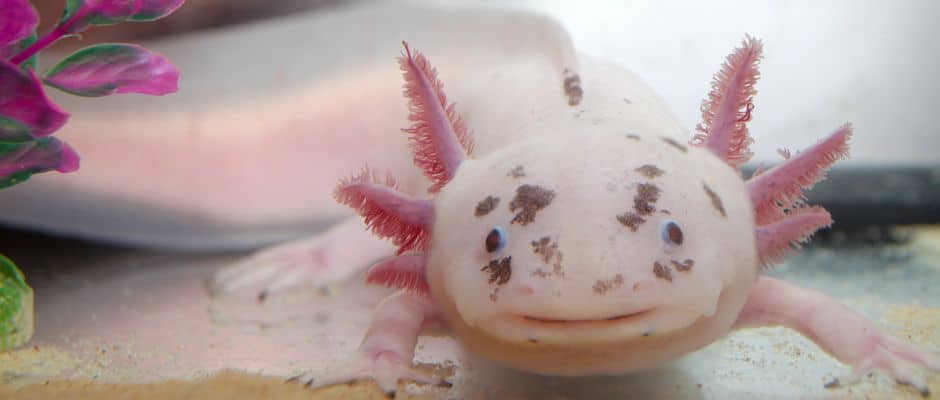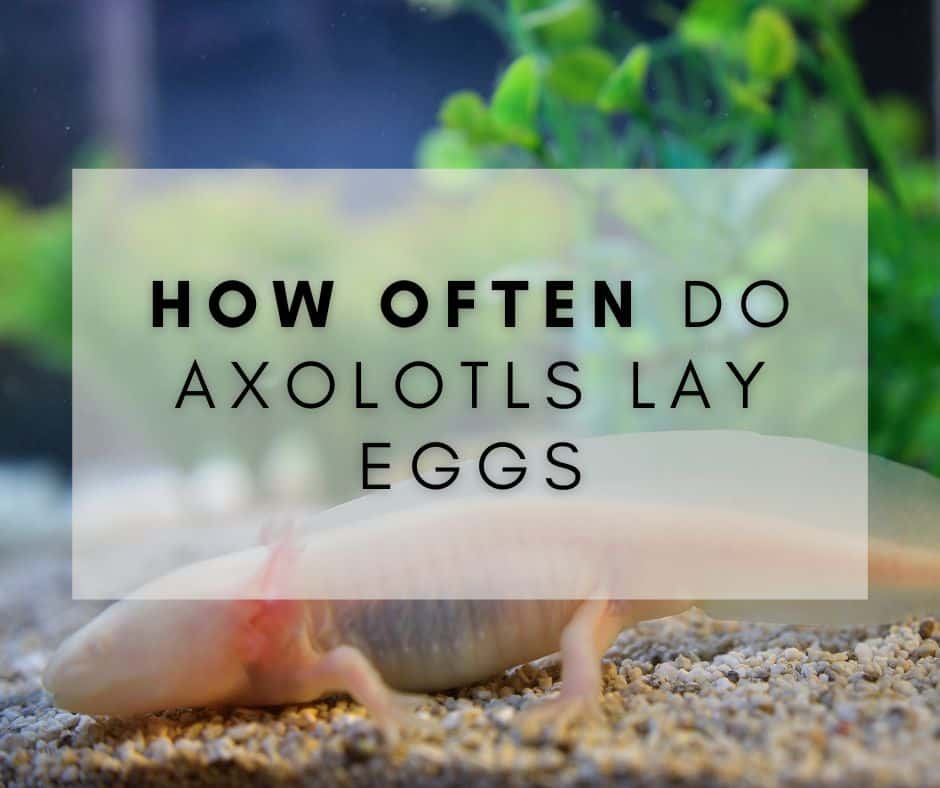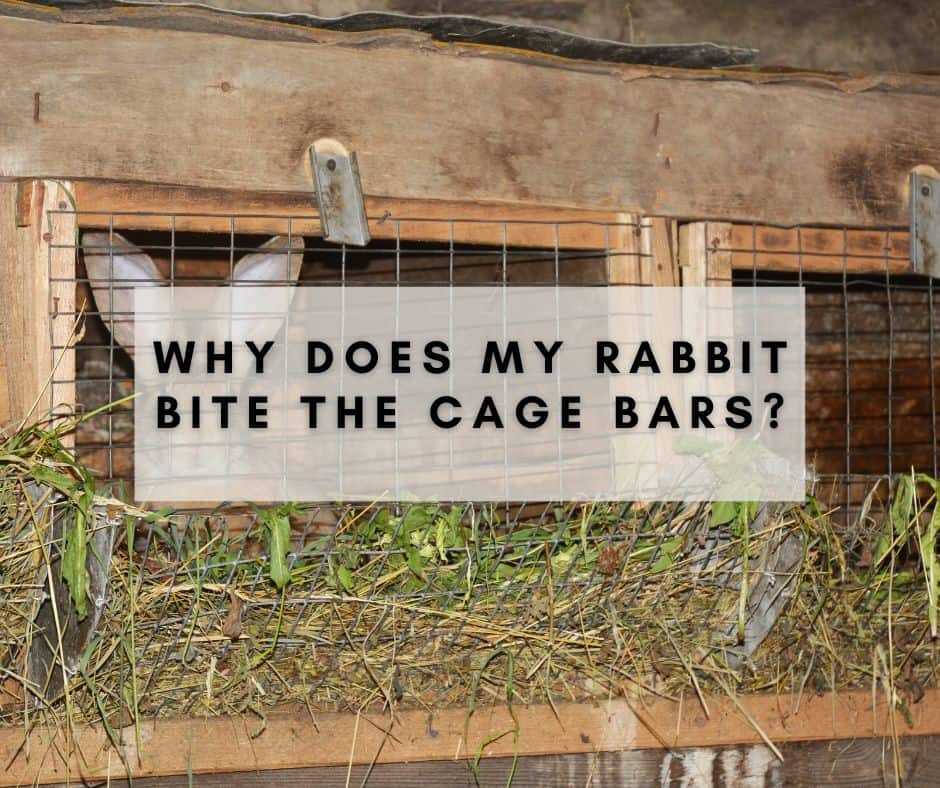Axolotls are like the equivalent of rabbits in breeding. They breed fast and in large amounts.
When putting a female and a male in the same aquarium, breeding will happen constantly.
As long as they have the right breeding conditions, you can expect around 1,000 eggs.
As a general rule, if you keep male and female axolotls in the same tank, you will be seeing eggs almost constantly. To minimize any possible strain on the female body, it is recommended to limit breeding to no more than once or twice a year.
The way axolotls reproduce is quite interesting. Simply put, they are external fertilizers.
This means that the male will release sperm and the female will lay her eggs outside of her body.
The female will then pick up the sperm with her cloaca and it will be stored inside until it is ready to be laid.
Once the eggs are laid, it will take about two weeks for them to hatch into larvae and start swimming around.
Contents
- 1 Axolotls are nearly extinct in the wild(!)
- 2 How often do axolotls lay eggs?
- 3 How long does it take for axolotls to lay eggs?
- 4 How to make sure your axolotls mate/lay eggs
- 5 How to know if my axolotls successfully mated?
- 6 Where do axolotls lay their eggs?
- 7 What to do after an axolotl lays its eggs
- 8 How many eggs will survive?
- 9 How to collect the axolotl eggs from the aquarium
- 10 Should I breed my axolotl right after giving birth?
- 11 Conclusion
Axolotls are nearly extinct in the wild(!)
It may be surprising to hear that axolotls are nearing extinction, but it’s the truth!
Most captive axolotls came from years of inbreeding, leading to a small gene pool.
There’s currently a lack of gene diversity in wild and captive axolotls, brought about by the destruction of their natural habitat.
According to this article, getting a 12% from the inbreeding coefficient means that the current population is mostly breeding with their first cousins.
Axolotls garnered 35% on average, meaning most suffer from health issues due to the risk of inbreeding.

How often do axolotls lay eggs?
They lay eggs constantly. Researchers have even reported that the species readily produce in the labs.
A healthy axolotl wouldn’t have problems laying their spawns, and there’s no need for hormones to induce breeding either.
In the wild, they breed and lay eggs at least once a year.
But in captive, some owners have reported seeing a new batch of eggs two weeks after the first one.
How long does it take for axolotls to lay eggs?
Usually, it takes 12 to 20 hours for females to lay eggs after mating. It’s rare for axolotls to go before or beyond that timeframe.
But if your axolotl is having trouble mating or laying eggs, then it might be because of their breeding conditions.
How to make sure your axolotls mate/lay eggs
While axolotls are capable of breeding constantly, they’re quite picky when it comes to their environment.
Your axolotls should be healthy
Healthy axolotls rarely hesitate when breeding, so check your axolotl’s health. For example, they should be well-fed and free of any parasites.
Your axolotls should have reached sexual maturity
Additionally, axolotls who have yet to reach sexual maturity are unable to breed.
Make sure your female axolotls are up to a year old. Otherwise, they’ll be incapable of mating.
The right temperature and lighting conditions
According to national geographic, February is the wild axolotl’s mating season.
While captive axolotls do not display much seasonality, try and imitate the temperature and lighting conditions during February.
Researchers have also found that more exposure to light can induce more spawn.
With this in mind, try to expose your axolotl to 14 hours of light time.
How to know if my axolotls successfully mated?
You could try and observe your aquarium from time to time.
Usually, males will do a mating dance before scattering their sperm.
If they have successfully enticed the female, she will follow to the area where the male deposits his sperm.
The female will then pick it up, and after a day or so, you’ll find fertilized eggs scattered around the floor.
Where do axolotls lay their eggs?
Axolotls do not form clumps of eggs like other species do.
Instead, you’ll see them scattered around the floor, some attached to rocks or plants.
If your aquarium doesn’t have any decor in it, try and find the eggs among the substrates.
What to do after an axolotl lays its eggs
Axolotls are creatures that are capable of eating their spawn.
When they lay their eggs, you should think about removing the axolotl from the aquarium or the eggs themselves.
Fortunately, you still have quite the window time before you remove anyone.
Axolotls usually eat their hatchlings once they’ve aged past their jelly coats.
How many eggs will survive?
You don’t need to worry much, axolotl eggs have a high survival rate of 95%.
While it means that you’ll likely see them progress into adulthood, you should remember about the years of inbreeding.
Some may grow to have a lower immune system or other genetic diseases
Although, they do have fewer inbreeding problems than other mammals.
As a responsible axie owner, you should also keep in mind the issues of captive overpopulation.
How to collect the axolotl eggs from the aquarium
If you’ve decided to remove the eggs instead of the axolotl, here are some tips on how to do it.
You’ll be needing:
Getting the eggs
Using a pipette with a wide opening, carefully collect individual eggs.
If you find eggs stuck to rocks or plants, carefully remove them with forceps.
Their jelly coats, used as a barrier against physical injury or infection, should protect them from the process.
Storing the eggs
Slowly deposit the eggs into the shallow bowl. Do not stick them close together.
Do not try to put all the eggs into one bowl. The ratio should be 50 eggs: 1 bowl.
If you do, they’ll form a clump, and the one in the middle will die or develop slowly due to the lack of oxygen.
If you see a clump, use the forceps once again and separate them from each other.
Should I breed my axolotl right after giving birth?
No, birth takes a toll on your axolotl’s body. It would be too much stress.
Not only does it expend high levels of energy, but an axolotl’s body also prioritizes birth above general body functions.
This means your axolotl will use up all their energy and nutrients for the sake of giving birth.
At best, you should breed them at an interval of three months.
Conclusion
If kept in one space (with the right breeding conditions), your male and female axolotl will breed constantly.
They’re even able to produce a new batch just after two weeks!
That’s why it’s integral to separate them right after you’ve bred them. Otherwise, you’ll have to deal with overpopulation.




